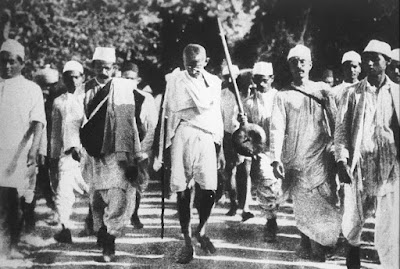 |
| Image Courtesy: Wikipedia |
Introduction:
India was under the rule of British. The British came in India through the East India Company and slowly colonized the country.
In the year 1915 Mahatma Gandhi returned from South Africa and introduced a new method of Mass Agitation called Satyagraha which was based upon the principle of truth and non violence. Gandhi used Satyagraha for conflict resolution which had three pillars.
Ahimsa -which means to respecting everyone and avoiding violence towards others, secondly the Sat which means honesty, fairness, most importantly truth and last pillar was Tapasya which is a willingness for self- sacrifice.
Here the Satyagrahis must be ready or willing to sacrifice anything in the occasion of the struggle which they had initiated.
First Satyagraha in India:
He organized unified peasants movement 3 times in the country. Firstly in 1917 in Champaran Bihar as peasants struggled against the oppressive plantation system. On an invitation by Rajkumar Shukla Mahatma Gandhi studied the situation of Indigo plantation workers in Champaran district.
The peasants were forced made to grow Indigo on the 3/20 parts of their field that too on lease. An Enquiry committee was formed by the British officials where Mahatma Gandhi was also a member of it.
For Mahatma Gandhi it was not a big task to convince the British officials about the difficulties the peasants were facing. It resulted into release of Indigo cultivation of the bondage of European. Hence, this was the first attempt of mass mobilization by Mahatma Gandhi.
Second attempt was in 1918 Kheda Gujarat where Satyagraha was done to support the people for revenue relaxation. There was a crop failure which made difficult for the people to pay taxes to the British government. However the government refused and harassed the peasants for revenue.
In this second attempt Mahatma Gandhi and Sardar Vallabhbhai Patel was in one team and fought against the injustice done on poor farmers and even asked the rich farmers to support by not paying the revenue.
Later on the British authority came out with the policy which asked the rich farmers to pay their due revenue.
In 1918 there was a mill strike in Ahmedabad Gujarat for the rise the wages. This happened because earlier the mill owners increased pay up to 75% to attract more workers but after some time they reduced the pay to 20%.
The workers did not agree with this and demanded for 50%. Gandhiji met both the parties but the mill owners refused to accept the demands of the peasants.
Mahatma Gandhi advised the mill workers to go on strike and as it didn’t worked out so they went on fast. This created pressure on the mill owners there after they agreed to increase the pay up to 35%.
This was the other Satyagraha which took place. All this three Satyagraha stood to be very successful after which Mahatma Gandhi launched national wide Satyagraha in the country
Rowlatt Satyagraha:
The British government introduced Rowlatt Act to crush this protest of Satyagraha in 1919. The Rowlatt Act was basically an act which means that the British official to imprison any Indian political leader for two years without any trail.
After which Mahatma Gandhi introduced the Rowlatt Satyagraha against this unlawful law. Several Indians participated in the Rowlatt Satyagraha by closing the shops and started protesting and organizing rallies.
British government ruling India they were scared and to crush this movement they brought Martial Law which was meant to have control over the protestors through military directly. The commando of the Martial Law was General Dyer.
Jallianwala Bagh Incident:
An incident on 13th April 1919 took place at Jallianwala Bagh Amritsar, where hundreds of innocent people were shot to death by General Dyer and many others were injured.
This created havoc anger among the people at Jallianwala Bagh. This incident created violence and ended the movement.
As the news of this tragedy spread throughout the country and violence began in all the parts of India because of which Gandhiji was forced to call of the Rowlatt Satyagraha.
This is how the medial movement came to an end because the angry people started attacking the government buildings, Police stations which gave rise to violence.
Mahatma Gandhi always believed in nonviolence and hence the movement of Satyagraha was introduced but due to the nonviolence it came to an end too.
The Backbone of Satyagraha Movement:
The ideas of Satyagraha were given by Kasturba Gandhi to Mahatma Gandhi. This movement created awareness among the Indian women which represented the active participation of women's in the freedom struggle along with the men too.
His aim was to have equality among the women and men in the society as women's can bring more transformation in the society and then in nation.
Conclusion:
Mahatma Gandhi is one of the greatest personalities in the history of India. He introduced and organized Satyagraha for the people of India to get freedom from the British rule.
Gandhiji used this mass movement to have full freedom that is Purna Swaraj before independence and after independence this movements are being pursued by our leaders such as Anna Hazare, Prakash Narayan, Baba Ramdev etc.
This people use his teachings as an instrument for raising voice against corruption in India.
Satyagraha was not only the process or any weapon used for conflict resolution but it was a way of life that an individual must prefer as it was based upon the principle values of truth and non-violence resistance movement.
Written by: Rakhi Sharma
Edited by: Gourav Chowdhury




.jpeg)





0 Comments